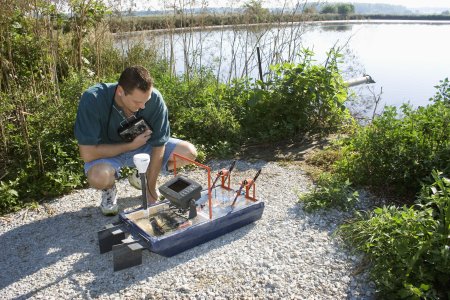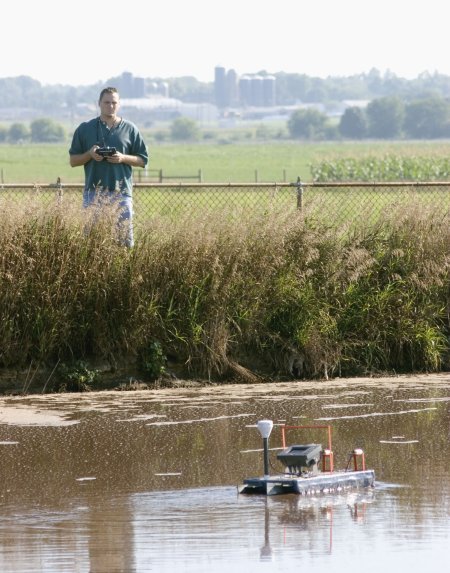
2005 Year in Review
Back to Page two: Recreation & Adult Education Listing | Back to Year in Review Index
Move Over, Love Boat: U of I Creates Mini 'Sludge Boat' |
|
Source: Matt Robert; (217) 333-2611; mrobert1@uiuc.edu; Author: Leanne Lucas The "sludge boat" is a far cry from the Love Boat, as it cuts a wake across a manure storage lagoon on the South Farms of the University of Illinois. But the sludge boat has the potential of making life a lot more pleasant for livestock farmers. U of I researchers have designed a small, remote-controlled boat that can sail across a waste treatment lagoon, measuring the amount of sludge in the lagoon along the way. The mini boat eliminates both the hazards and the hassles of measuring sludge the old-fashioned way--by sticking a pole into various spots of the lagoon. The fiberglass boat measures approximately 1-foot by 2-foot and uses a fish finder combined with GPS to determine the depth of the sludge and its location in the lagoon, said Matt Robert, a visiting research engineer with the department of Agricultural and Biological Engineering. Sludge is the nutrient-dense material that is left in a lagoon after bacteria have digested most of the organic concentration of the livestock waste, he said. New EPA regulations require livestock producers to know how much sludge is in their lagoon. Traditionally, producers have had to take a small boat and a long pole out on the lagoon, sticking the pole in at various spots, measuring the amount of sludge you find at each spot and mapping it all out as you go. "It's a lot of tedious work and it's dangerous, not to mention the fact that you're in a very unpleasant place," Robert said. So Robert and a student, Andrew Lenkaitis, decided to build their own boat after speaking with researchers at other universities who were working on similar projects. "North Carolina and Texas A & M bought a boat to use, but they were having problems with the different idiosyncrasies of taking it on a lagoon, as compared to just regular water," he explained. "We knew we'd have the same problems, so when Andy said he wanted to build it, we were excited to see what he could do with it." The result is a fiberglass hull that is propelled by air, with two battery-powered electric motors. The "heart and soul" of the boat, said Lenkaitis, is the fish finder and GPS module. Most of the components are completely sealed from the environment and the boat has a sturdy handle that makes loading it and unloading it a one-person job. "We'd like to be able to go around the state to measure lagoon depths," said Robert, "and this is a very easy way to do it. There are a lot of lagoons from the 1970's and the accumulation depth on them is going to be significant." Robert believes this technology will allow producers to be more environmentally friendly by practicing better lagoon management. "We'd also like to write a paper for Extension and let producers build these boats themselves," he added. "Almost all the components for the boat can be purchased off the shelf at your local hobby shop. The total cost is less than $1,800." Although Robert is eager to share this technology with producers, he's just as pleased to have it for himself as well. "One day I came back from a lagoon and I was messy and tired, and tired of doing this. The sludge boat came out of a long conversation I had with a colleague about ways to make my life easier," Robert said. "I hope I'll never have to get on another lagoon again." by Editor, theCity1.com |
|
Copyright © 2005 TheCity1.com.
All rights reserved

